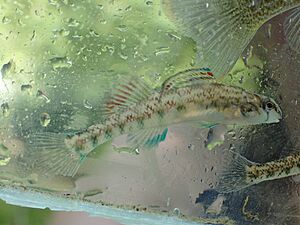Coosa darter facts for kids
Quick facts for kids Coosa darter |
|
|---|---|
 |
|
| Conservation status | |
| Scientific classification | |
| Synonyms | |
|
The Coosa darter (Etheostoma coosae) is a small, colorful freshwater fish. It's a type of darter, which belongs to the same fish family as perches. This special fish is found only in a specific river system in the eastern United States.
Contents
What Does the Coosa Darter Look Like?
The Coosa darter is a sturdy little fish. It has a rounded snout and a small mouth. Its top fin, called the dorsal fin, has cool color bands. There's a red stripe running down the middle of this fin. Above and below the red stripe, you'll see clear and dark bands. The soft part of the dorsal fin also has red in the middle of its membranes.
The body of the Coosa darter is a yellow-olive color. It has 8 or 9 dark spots along its back and sides. The lower part of its snout and its throat are light green. Its bottom fin (the anal fin) and the top and bottom parts of its tail fin (the caudal fin) are a pretty turquoise color. The spots on its sides sometimes have a slight green tint.
The longest Coosa darter ever measured was about 7.2 centimeters (2.8 inches) long. However, most males are around 4.1 centimeters (1.6 inches) long, and females are about 3.9 centimeters (1.5 inches) long.
Where Does the Coosa Darter Live?
The Coosa darter is only found in the Coosa River system. This river system flows into Mobile Bay. You can find these fish in parts of Georgia, Alabama, and Tennessee.
Home and Habits of the Coosa Darter
Coosa darters like to live in rocky pools and fast-moving parts of creeks and small to medium rivers. They also live in streams.
They mainly eat the tiny larvae (baby forms) of midges and blackflys. They also munch on smaller amounts of other tiny water creatures like cladocera, copepods, mayfly nymphs, and caddisfly larvae. During summer, they eat more insects, especially flies. In winter, they eat more crustaceans (like tiny shrimp).
Coosa darters usually lay their eggs from mid-March to mid-May. The female lays one egg at a time. She places it carefully into small cracks or spaces in wood, rocks, or other hard surfaces. The male then fertilizes the eggs right after they are laid. They can lay eggs in any position, from flat to upright.
Is the Coosa Darter in Danger?
The IUCN (International Union for Conservation of Nature) has listed the Coosa darter as a species of "Least Concern". This is good news! It means they are not currently in danger.
The Coosa darter lives in a large area within the Coosa River system. There are many of them, and they have lots of different groups. Their numbers seem to be stable, and experts haven't found any major threats to them right now.


